Overview
The article "Understanding ABA Services Meaning: Key Insights for Parents" aims to clarify the concept and significance of Applied Behavior Analysis (ABA) services for parents of children with autism. It emphasizes that ABA is a scientifically-based approach designed to improve communication, social skills, and daily living abilities through tailored interventions. This highlights the importance of individualized treatment plans and the critical role of Board Certified Behavior Analysts (BCBAs) in enhancing the effectiveness of these services. By understanding ABA, parents can feel more empowered and supported in their journey.
Introduction
In the journey of child development, Applied Behavior Analysis (ABA) therapy emerges as a beacon of hope for families navigating the complexities of autism spectrum disorder (ASD) and ADHD. This therapy, grounded in scientific methodologies rooted in behaviorism, seeks to understand and modify behavior through reinforcement strategies. The ultimate goal? To enhance the quality of life for children, offering them the support they need to thrive.
What makes ABA therapy truly special is its emphasis on individualized treatment plans. Each child is unique, and so are their needs. Board Certified Behavior Analysts (BCBAs) play a crucial role in crafting effective interventions that cater to these specific requirements. As the field continues to evolve, innovative techniques and data-driven practices are reshaping the landscape of ABA therapy, fostering meaningful progress and empowering children to reach their full potential.
With ongoing research validating its effectiveness, ABA therapy stands as a vital resource for families seeking tailored support. It acknowledges and celebrates each child's unique strengths and challenges, providing a nurturing environment where they can flourish. If you're a parent looking for guidance, know that you are not alone—ABA therapy is here to support you and your child every step of the way.
Define ABA Therapy: Understanding Its Core Principles
The meaning of ABA services refers to Applied Behavior Analysis (ABA), a scientific approach dedicated to understanding and modifying behaviors through the principles of behaviorism. This perspective holds that behaviors are learned and can be adjusted through reinforcement strategies. At the heart of ABA services are essential components such as positive reinforcement, which encourages the repetition of desired behaviors through rewards, and systematic observation, guiding tailored interventions.
Recent studies highlight the effectiveness of these principles, showing significant improvements in treatment outcomes when applied consistently. Additionally, Board Certified Behavior Analysts (BCBAs) play a vital role in the shift toward value-based care, ensuring compliance with payer requirements while enhancing the overall effectiveness of ABA services.
The responsibilities of ABA therapists can be quite demanding, making it crucial to develop wisdom for managing job-related stress. Fortunately, technological innovations from platforms like Raven Health are transforming the delivery of ABA services. By automating administrative tasks and enhancing the analysis of treatment progress through AI-powered analytics, these advancements allow therapists to customize strategies to meet the unique needs of each individual, whether in home care, educational settings, or community environments.
As Alex Jones wisely states, 'Focus on abilities, not disabilities.' This sentiment encapsulates the positive change that is the essence of ABA support. As the field continues to evolve, ongoing research consistently affirms the efficacy of ABA services, reinforcing its role in fostering positive change for youth with autism and ADHD. Together, we can support these children and their families on their journey toward growth and understanding.
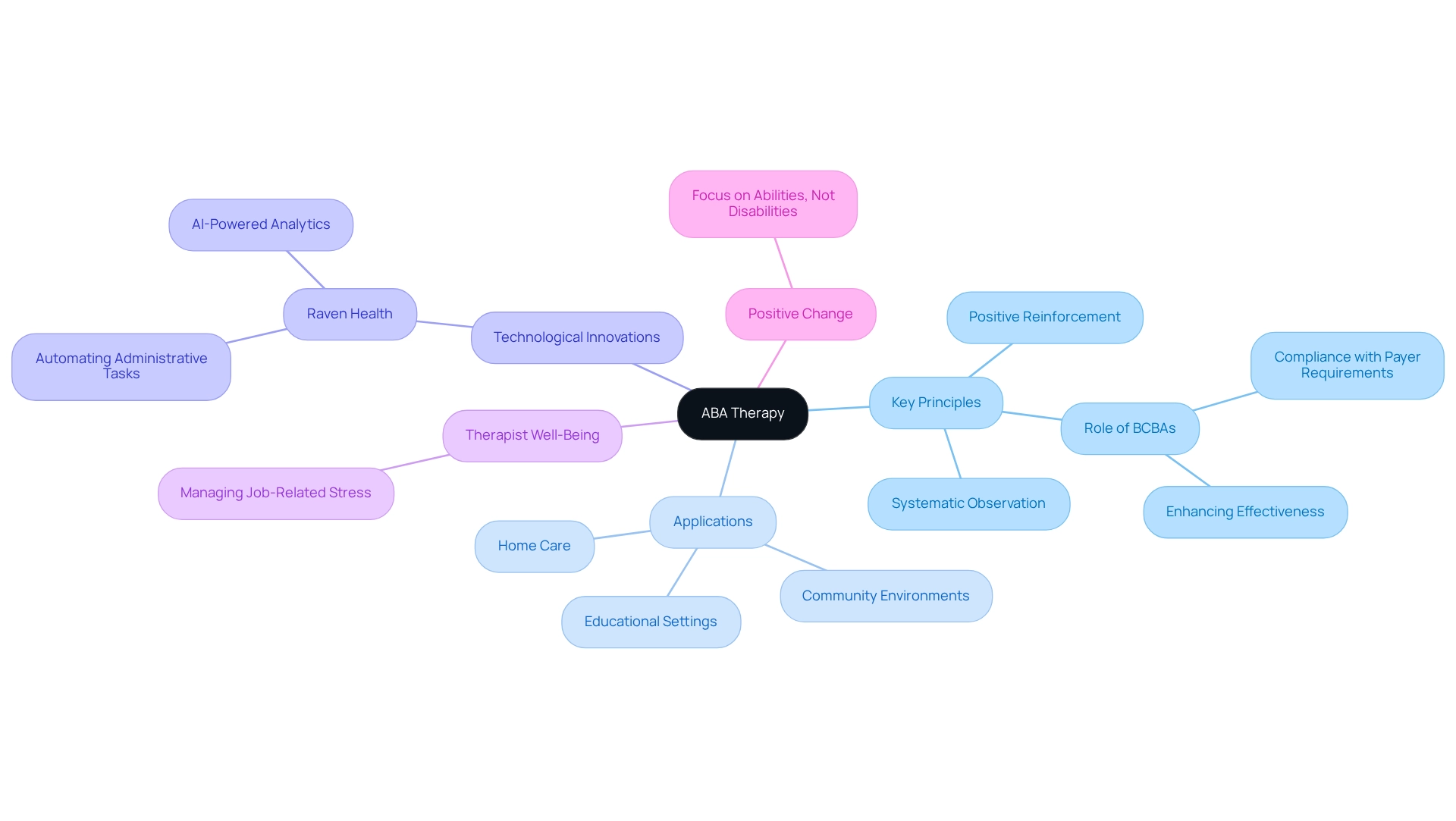
Explore Techniques: Common Methods in ABA Therapy
When it comes to understanding ABA services, it's important to recognize the various techniques that facilitate learning and modify behaviors. One foundational approach is Discrete Trial Training (DTT), which breaks down complex skills into smaller, manageable tasks. This method allows for focused teaching and reinforcement, making it easier for children to grasp new concepts.
Another effective technique is modeling, where therapists demonstrate specific actions for children to replicate, promoting learning through observation. Additionally, the Picture Exchange Communication System (PECS) employs visual aids to enhance communication skills among children with autism, fostering their ability to express needs and wants.
Reinforcement systems play a crucial role in encouraging desired behaviors. By offering rewards or incentives, therapists motivate children to engage positively. Techniques such as prompting and fading are also essential, as they guide children toward independence by gradually reducing support as they learn new skills. Research has shown that methods like DTT significantly improve behavioral outcomes, with many practitioners highlighting its effectiveness in their practice.
Recent statistics reveal that the adjusted prevalence estimate of Autism Spectrum Disorder (ASD) in upper middle and higher-income countries from 2015-2019 was 1.18%. This underscores the growing need for effective ABA services to support this population. For instance, a case study on occupational support illustrates how targeted interventions can address sensory processing challenges, enhancing children's participation in daily activities. This case study highlights the importance of collaboration among therapists, families, and individuals with autism. Medicaid plays a vital role in ensuring that children with autism receive the necessary care to thrive. Such insights emphasize the value of teamwork in maximizing the benefits of ABA services.
Identify Benefits: How ABA Therapy Supports Child Development
The meaning of ABA services encompasses interventions that have demonstrated a remarkable ability to enhance communication skills, social interactions, and daily living abilities in individuals with autism. For many parents, understanding this can be a source of hope. Studies show that youth engaged in ABA interventions often experience significant reductions in challenging behaviors, such as tantrums and aggression, while simultaneously improving their interactions with peers and adults.
However, it's crucial to recognize that the demand for further research in this area remains high, especially concerning single-case studies. Ralph Moller emphasizes that by focusing on the unique needs of each individual with autism, treatment can be tailored to meet specific goals and foster progress. This personalized approach not only nurtures self-care skills but also enhances academic performance and aids in emotional regulation, ultimately paving the way for a more independent and fulfilling life for these young individuals.
For parents, grasping the meaning of ABA services can empower them to advocate effectively for their children's needs. It opens the door to seeking customized ABA treatment that aligns with their children's unique challenges and aspirations. By taking this step, parents can play a pivotal role in their child's journey toward growth and fulfillment.
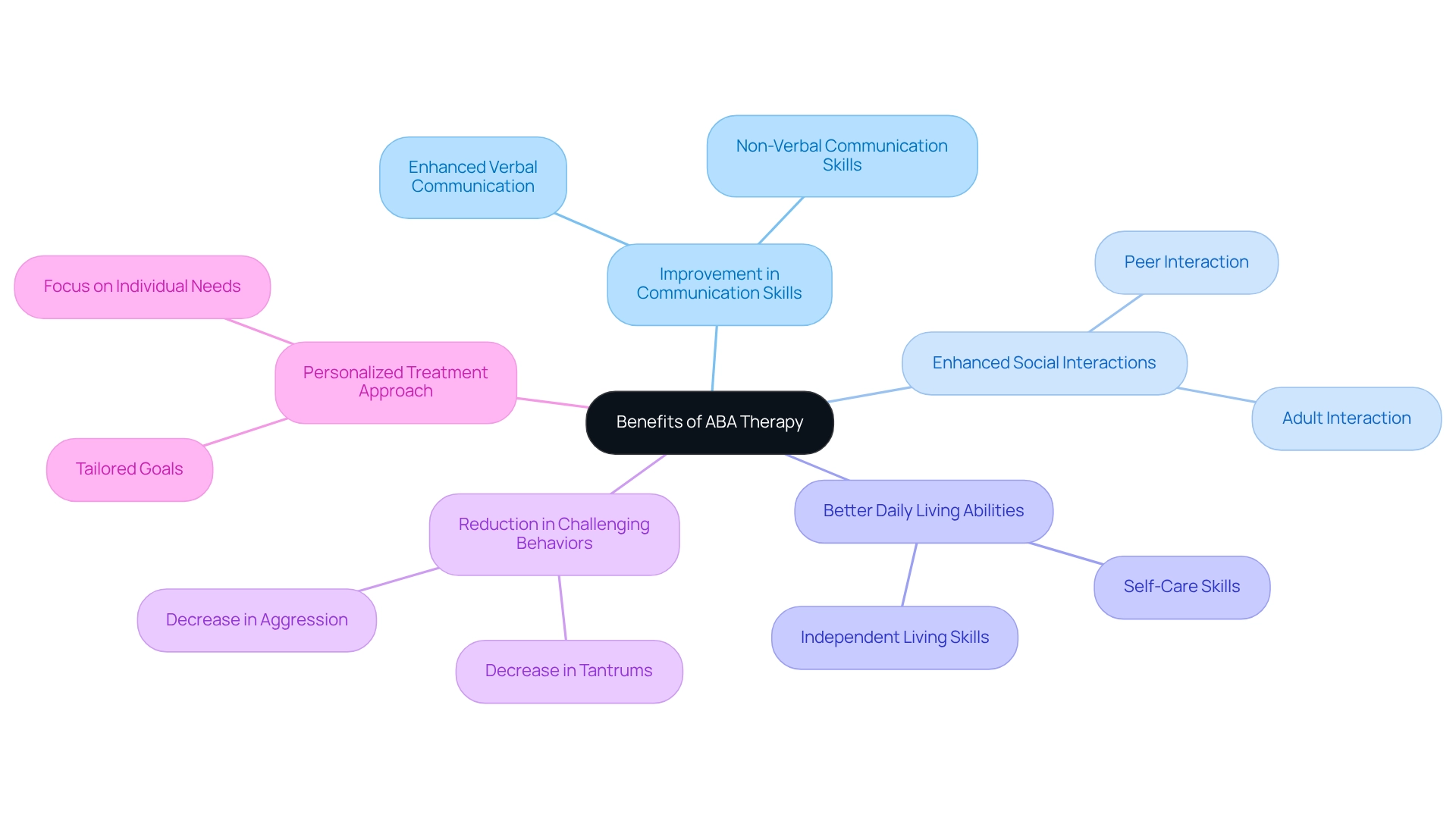
Understand Individualization: The Role of Customized Treatment Plans
Customized treatment plans are vital for understanding ABA services, as they ensure interventions are tailored to each individual's unique strengths, challenges, and preferences. These plans emerge from comprehensive evaluations that delve into the individual’s actions, abilities, and environmental factors. Research shows that personalized treatment plans significantly enhance the effectiveness of ABA services, with individuals receiving these tailored strategies demonstrating improved outcomes in behavior and skill acquisition. Furthermore, a survey by the American Psychological Association reveals that over 60% of students report experiencing daily stress, highlighting the urgent need for customized strategies to alleviate stress and enhance results.
Regular reviews and adjustments to these treatment plans are essential for maintaining their relevance and effectiveness. As children grow, therapists must adapt their approaches to meet evolving needs. This dynamic strategy not only fosters better engagement but also supports each individual's journey toward self-actualization, a central goal in ABA practice. As Debra Muzikar wisely notes, "Autism is not a roadblock but a detour to a different destination, filled with unique opportunities." By prioritizing individualization, practitioners can cultivate a more supportive environment that recognizes the unique experiences of each child, ultimately leading to more successful therapeutic outcomes. Additionally, education plays a crucial role in understanding behavioral health, as illustrated in the case study titled 'The Role of Education in Understanding Behavioral Health.' This study emphasizes how educational and emotional backgrounds influence treatment, reinforcing the need for personalized approaches within the context of ABA services.
Clarify Misconceptions: Debunking Myths About ABA Therapy
Misconceptions surrounding the meaning of ABA services often lead to misunderstandings about its purpose and effectiveness. Many believe that ABA focuses solely on compliance or aims to 'cure' autism. In truth, the meaning of ABA services is to enhance the quality of life for individuals with autism by teaching functional skills and fostering positive behaviors. It is not about conformity but rather about empowering youth to navigate their environments more effectively.
Another prevalent myth is that ABA creates robotic responses in individuals. However, effective ABA interventions utilize naturalistic methods that respect each individual’s unique personality and encourage genuine interactions. This approach motivates young individuals to interact thoughtfully with their environment, boosting their communication and social abilities.
Studies have indicated that ABA techniques greatly enhance vital life skills, such as communication, social engagement, and self-assistance capabilities. The meaning of ABA services is evident in how each individual's treatment plan varies based on age, abilities, and needs, ensuring a tailored approach that meets personal requirements. For instance, a case study highlighted how young individuals undergoing ABA treatment not only decreased problem behaviors but also gained greater independence and self-worth. This underscores the approach's role in promoting genuine growth rather than mere compliance.
Furthermore, public perception often misrepresents ABA's effectiveness. Statistics indicate that a long-term commitment to ABA, coupled with consistent family support, is crucial for achieving meaningful results. As noted by experts, 'Progress depends on various factors including the individual’s needs, the consistency of sessions, and the support from family or caregivers.' Max Lowy's extensive experience in the healthcare industry further emphasizes the importance of expert guidance in navigating these complexities. By addressing these misunderstandings, we can better appreciate the transformative potential of ABA treatment for youth with autism, while recognizing how public misconceptions can impact the effectiveness of the intervention.
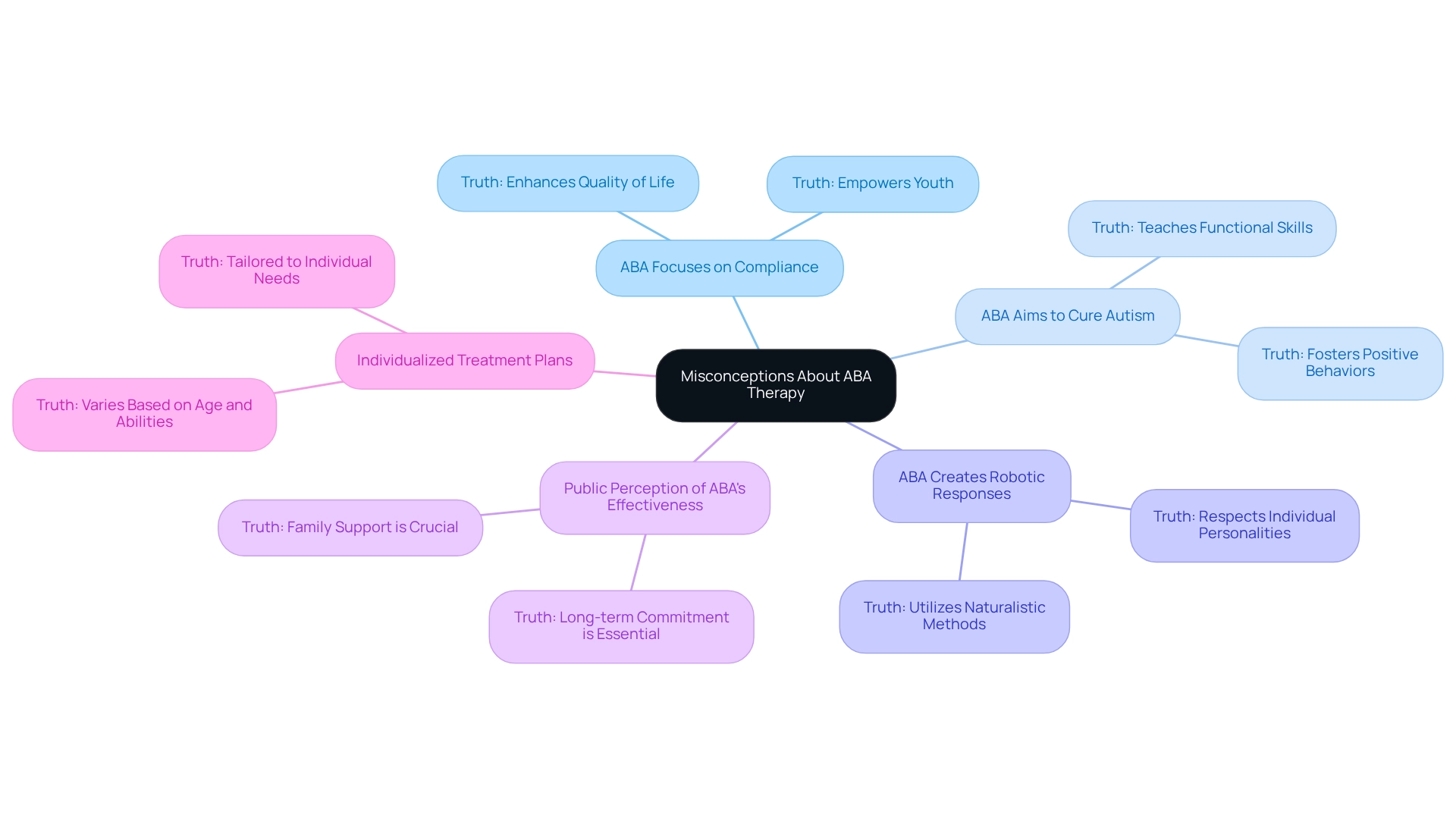
Recognize Data-Driven Decisions: The Importance of Tracking Progress
Data gathering is a cornerstone of ABA treatment, allowing therapists to closely track a young person's progress over time. By systematically documenting behaviors, therapists can evaluate the effectiveness of interventions and make necessary adjustments. This data-driven approach ensures that treatment is tailored to the young person's evolving needs, ultimately fostering more successful outcomes. Regular progress reports not only keep parents informed but also actively involve them in their child's development. Recent findings highlight that consistent monitoring can significantly enhance the efficacy of ABA therapy. Research indicates that individuals whose progress is carefully tracked exhibit greater advancements in conduct and skill acquisition.
For instance, a case study on the significance of data collection revealed that therapists employing detailed tracking methods reported a 30% increase in positive changes among their clients. Specialists in the field emphasize that efficient data gathering transcends mere figures; it’s about understanding each individual's unique journey and focusing on their potential achievements. As one behavior analyst noted, 'The insights gained from tracking progress are invaluable in shaping individualized treatment plans that truly resonate with the child's needs.'
Additionally, the emotionally challenging aspects of ABA treatment require therapists to possess the knowledge to manage the stress associated with their responsibilities. This wisdom can be bolstered by effective data collection, which provides clarity and direction in their work. Recognizing the importance of self-care for therapists is equally essential, as it directly impacts their capacity to offer effective support. This commitment to data-driven decisions not only aids therapists in managing their responsibilities but also empowers families to be active participants in the therapeutic process. Together, we can create a nurturing environment that supports the growth and development of our children.
![]()
Meet the Professionals: Understanding the Role of Behavior Analysts
Board Certified Behavior Analysts (BCBAs) play a crucial role in the successful execution of Applied Behavior Analysis (ABA) treatment, and their work is truly commendable. They conduct thorough assessments, develop individualized treatment plans, and supervise the execution of interventions with great care. BCBAs adhere to ethical standards, ensuring that therapy is delivered effectively while providing essential guidance to therapists and support staff. Their expertise is vital for evaluating progress and making necessary adjustments to improve outcomes for children, who are at the heart of their mission.
Statistics indicate that BCBAs are dedicated to respecting the dignity and welfare of their clients while promoting autonomy. This commitment shines through in their therapeutic approach, where every small victory is celebrated as a stepping stone toward larger successes. For instance, the case study named 'BCBA in Practice' demonstrates how BCBAs utilize analysis techniques in practical environments, highlighting their substantial influence on individuals encountering conduct challenges. This case study exemplifies the BCBAs' dedication to client dignity and autonomy by showcasing how they tailor interventions to meet individual needs, fostering a sense of hope and progress.
As we look ahead to 2025, the role of BCBAs continues to evolve, underscoring the necessity for professionals to engage in ongoing education and training to stay updated with the latest research and advancements in behavior analysis. Their qualifications and training are essential, providing them with the knowledge required to implement effective interventions customized to each individual's unique needs. Expert viewpoints consistently stress the significance of BCBAs in the context of ABA services, emphasizing their duty to promote positive behavioral modifications and assist in the development of vital skills in individuals with autism and ADHD. As one unnamed specialist remarked, "With ABA, every step forward counts," reminding us of the importance of acknowledging and celebrating progress in treatment. Together, we can support BCBAs in their invaluable work, ensuring that every child receives the care and attention they deserve.
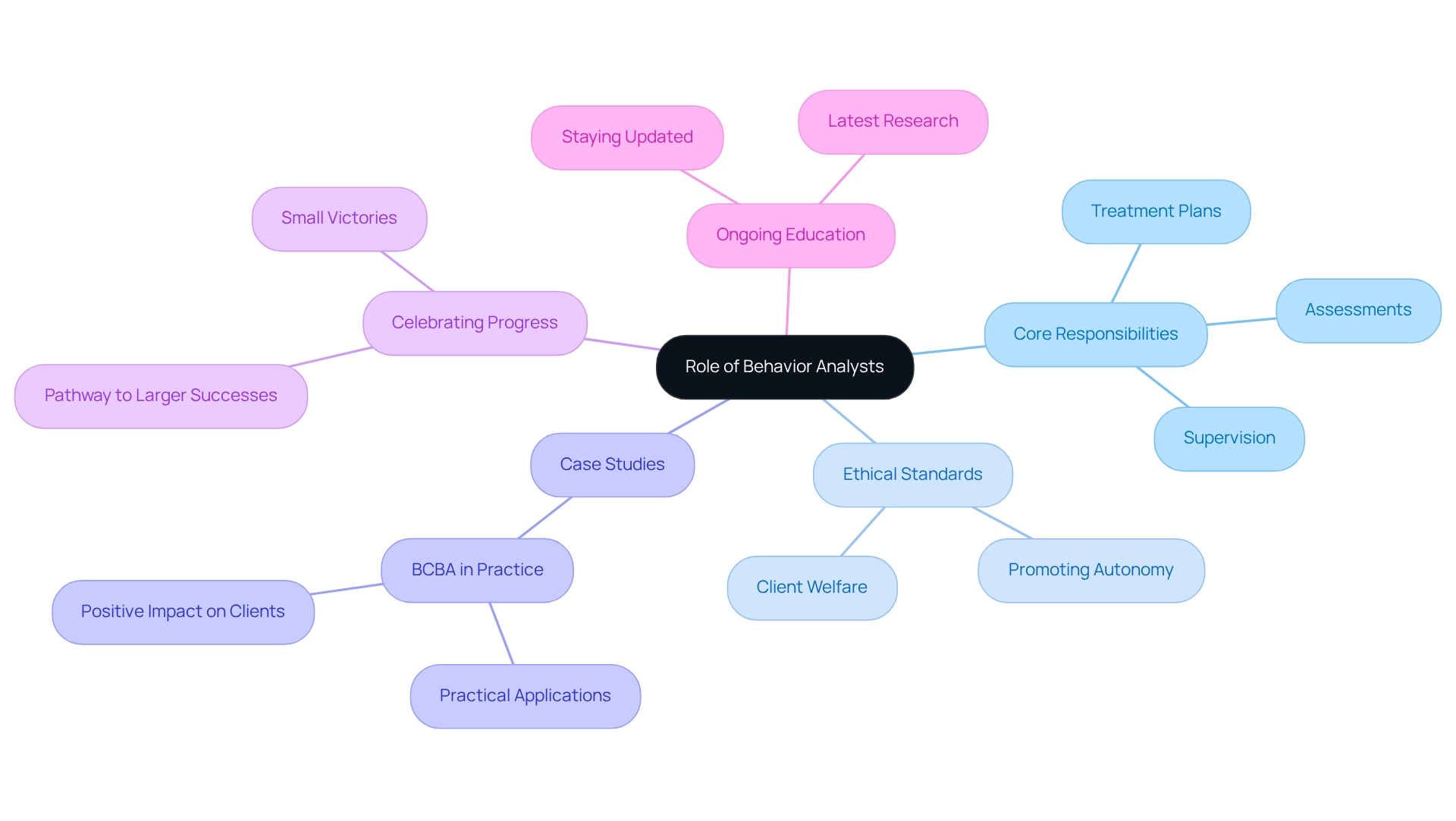
Anticipate Session Structure: What Happens in an ABA Therapy Session
An ABA session is designed to blend structured activities with natural interactions, creating an engaging learning environment for children. Typically, these sessions begin with a warm-up period, during which the therapist introduces preferred activities to build rapport and comfort. Following this, targeted interventions focus on specific goals, employing techniques such as Discrete Trial Training (DTT) and modeling. Throughout the session, therapists carefully collect data to monitor progress and adjust strategies as necessary.
Importantly, early intervention with ABA services has shown significant improvements in communication skills, cognitive abilities, and a reduction in the severity of autism symptoms for toddlers who participate in six months of sessions starting around age two. This highlights the effectiveness of organized activities in fostering development. Sessions wrap up with a review of achievements and a discussion of next steps, ensuring that parents remain actively informed and engaged in their child’s developmental journey.
Additionally, findings from the case study titled 'Exploring Complementary Approaches for Autism' suggest that incorporating complementary methods can enhance traditional treatments, offering a more holistic approach to autism care. Ralph Moller underscores the necessity of recognizing the overlap in symptoms between autism spectrum disorder (ASD) and other conditions like ADHD, to ensure that treatment plans effectively meet individual needs.
This structured approach not only improves learning outcomes but also nurtures a collaborative environment between therapists and families. Looking ahead, on April 3, 2025, an examination will take place to explore how ABA techniques can enhance sensory processing in youth, further contributing to the ongoing conversation about the benefits of ABA methods.
Plan for Commitment: How Long Does ABA Therapy Last?
The journey of ABA treatment is deeply personal, often spanning 2 to 5 years, tailored to the unique needs of each child. Many children begin with intensive sessions, typically receiving 20 to 40 hours each week. This commitment allows for remarkable skill development and behavioral improvements. As progress unfolds, families may transition to a part-time schedule, reflecting the evolving needs of their child. It's vital to remain dedicated to this process; consistent involvement fosters significant advancements in behavior and skills.
Regular assessments play a crucial role in this journey, helping to evaluate progress and adjust treatment plans. This ensures that each child receives the most effective support, customized to their individual circumstances. As ASD Media highlights, "Overall, the success stories linked to the aba services meaning underscore its potential to create meaningful change in the lives of individuals, regardless of their age." Furthermore, children as young as two can begin ABA therapy, underscoring the importance of early intervention.
Parents can utilize the skills acquired through ABA programs for long-term growth, reinforcing the value of ongoing engagement in the therapeutic process. A case study titled 'Tailored Intervention Strategies in ABA Therapy' exemplifies how these personalized approaches significantly enhance the functioning of young individuals, preparing them for lasting success. This journey is not just about treatment; it's about nurturing potential and fostering hope for a brighter future.
Navigate Insurance: Understanding Coverage for ABA Therapy
Understanding the meaning of ABA services and the insurance coverage available for these essential supports is vital for families seeking effective assistance for their children. Coverage for ABA treatment can vary significantly across states and providers. Many insurance plans, including Medicaid and private insurance, offer different levels of support. For instance, Wisconsin mandates a minimum coverage of $50,000 for intensive-level services, reflecting a growing recognition of the importance of ABA support in addressing autism spectrum disorder.
Parents are encouraged to carefully review the details of their insurance policies, including coverage limits, co-pays, and necessary documentation. Engaging directly with insurance representatives can help clarify any ambiguities, ensuring families are fully aware of their entitlements. Advocacy efforts from organizations like Autism Speaks have played a crucial role in improving coverage options, highlighting the need to stay informed about rights and available resources.
Recent case studies illustrate the positive impact of well-crafted legislation on service accessibility. For example, a partnership between the Children's Therapy Center and Ensora Health successfully reduced insurance processing time by over 20 hours weekly, showcasing how streamlined processes can benefit families. This aligns with broader trends indicating an increase in the number of Board Certified Behavior Analysts (BCBAs) and youth psychiatrists in states with generous mandates, emphasizing the favorable effects of supportive policies on service availability.
As Dr. Bob Wesley noted, "The authors would also like to thank Dr. Bob Wesley for statistical advice," underscoring the importance of expert insights in understanding these trends. As advocacy continues to evolve, families must remain proactive in navigating the complexities of insurance for ABA support, utilizing available resources to achieve the best possible outcomes for their children. Moreover, grasping the meaning of ABA services in the context of how Medicaid covers ABA therapy is crucial for many families, as it can significantly influence their access to necessary services.
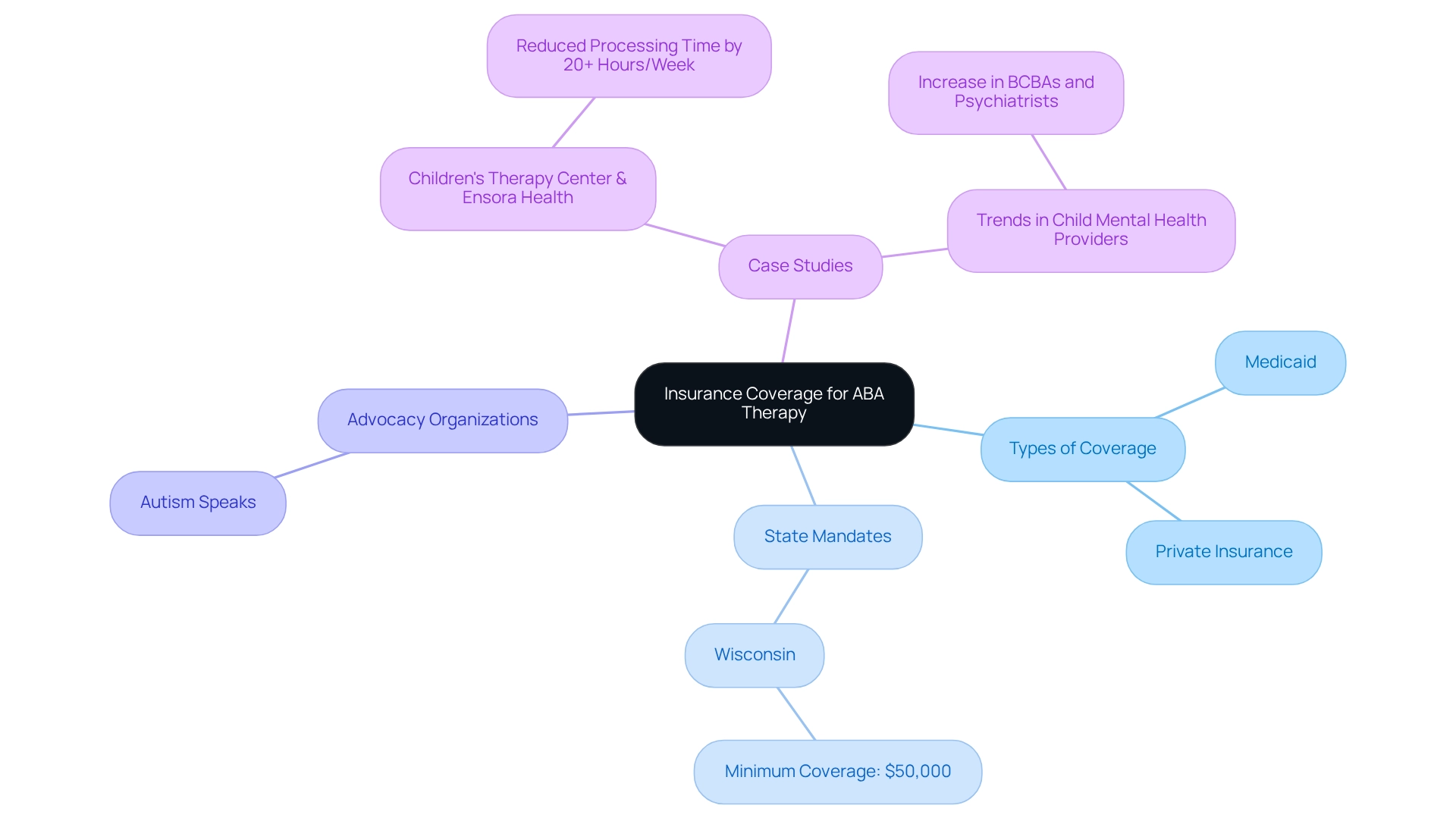
Conclusion
ABA therapy serves as a transformative approach for children with autism spectrum disorder (ASD) and ADHD, highlighting the significance of individualized treatment plans that cater to each child's unique strengths and challenges. By employing scientifically grounded techniques such as Discrete Trial Training, modeling, and reinforcement systems, ABA therapy effectively enhances communication skills, social interactions, and daily living skills. This ultimately paves the way for a more independent and fulfilling life for these children.
The role of Board Certified Behavior Analysts (BCBAs) is essential in this journey. They design and oversee personalized interventions while ensuring that ethical standards are upheld. Their expertise, combined with data-driven methodologies that track progress, reinforces the effectiveness of ABA therapy, allowing timely adjustments to treatment plans that meet each child's evolving needs.
Despite some misconceptions surrounding ABA therapy, ongoing research and real-world case studies reveal its potential to empower children, emphasizing their abilities rather than disabilities. By fostering a collaborative environment between therapists and families, ABA therapy not only supports individual growth but also encourages parents to actively engage in their child's developmental journey.
In conclusion, ABA therapy is an invaluable resource for families seeking tailored support for their children with ASD and ADHD. Its commitment to understanding and celebrating each child's unique journey ensures they receive the best possible care, leading to meaningful progress and an enhanced quality of life. As the field continues to evolve, staying informed about the latest techniques and advocacy efforts can further improve access to this life-changing therapy.
Frequently Asked Questions
What does ABA stand for and what is its purpose?
ABA stands for Applied Behavior Analysis, which is a scientific approach aimed at understanding and modifying behaviors through the principles of behaviorism.
What are the key components of ABA services?
Key components of ABA services include positive reinforcement, which encourages desired behaviors through rewards, and systematic observation, which guides tailored interventions.
How effective are ABA services according to recent studies?
Recent studies indicate that the consistent application of ABA principles leads to significant improvements in treatment outcomes.
What role do Board Certified Behavior Analysts (BCBAs) play in ABA services?
BCBAs are crucial in ensuring compliance with payer requirements and enhancing the overall effectiveness of ABA services, especially in the shift toward value-based care.
What challenges do ABA therapists face in their roles?
ABA therapists often deal with demanding responsibilities, making it essential to develop strategies for managing job-related stress.
How is technology impacting the delivery of ABA services?
Technological innovations, such as those from Raven Health, are transforming ABA services by automating administrative tasks and using AI-powered analytics to enhance treatment progress analysis.
What is Discrete Trial Training (DTT) in ABA?
DTT is a foundational approach in ABA that breaks down complex skills into smaller, manageable tasks, allowing for focused teaching and reinforcement.
What is the Picture Exchange Communication System (PECS)?
PECS is an ABA technique that uses visual aids to improve communication skills among children with autism, helping them express their needs and wants.
How do reinforcement systems work in ABA?
Reinforcement systems encourage desired behaviors by providing rewards or incentives, motivating children to engage positively.
What are the benefits of ABA services for individuals with autism?
ABA services can significantly enhance communication skills, social interactions, and daily living abilities, while also reducing challenging behaviors like tantrums and aggression.
Why is ongoing research important in the field of ABA?
Ongoing research is crucial for understanding the unique needs of individuals with autism and for developing tailored treatments that foster progress and improve outcomes.
How can parents advocate for their children's needs regarding ABA services?
By understanding the meaning and benefits of ABA services, parents can seek customized treatments that align with their children's unique challenges and aspirations, playing a pivotal role in their growth and fulfillment.




